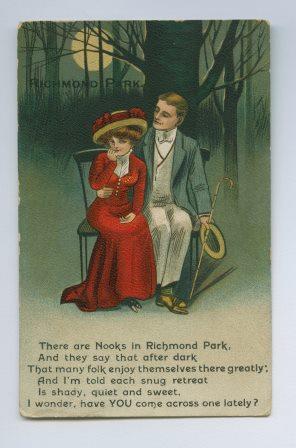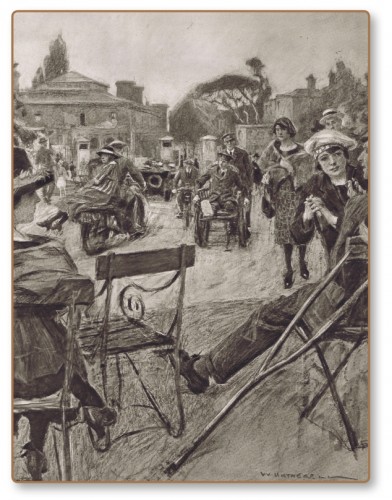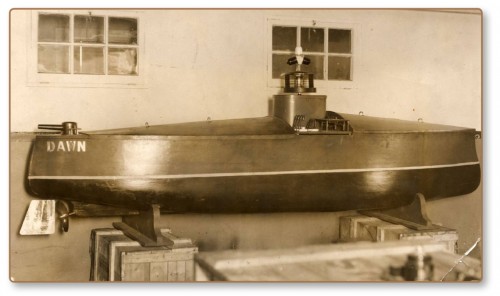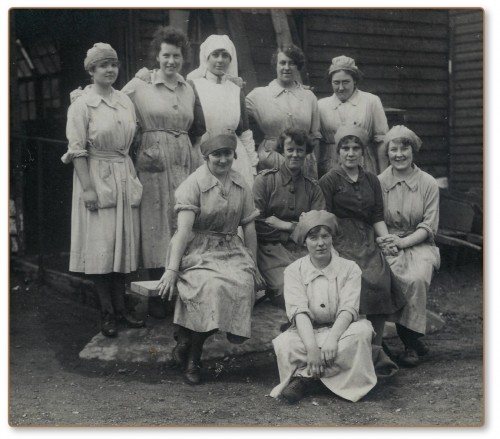From July 2014 to July 2015 the Hearsum Collection displayed a free exhibition at Pembroke Lodge about Richmond Park’s important role in the First World War.
The Park had army encampments, including a large camp near Roehampton for volunteer rifle regiments and a depot between Roehampton and Robin Hood Gate for the Royal Naval Air Service. Units were trained in the Park for battle, with the cavalry practising their charges across the grasslands.
The First World War (1914-18) was a conflict which affected everyone in Britain. Nothing like it had ever been seen before, not least in Richmond Park. The Hearsum Collection has a number of historic items which tell the stories of some of the notable activities that took place there at this time including military training, the construction of a fully-equipped hospital, a top secret experiment and women working on the Home Front.
Before the war
The period before the outbreak of war is sometimes seen as a golden age when Richmond Park was a place of leisure and genteel residence, as this hand-tinted postcard shows.
Soldiers in the Park
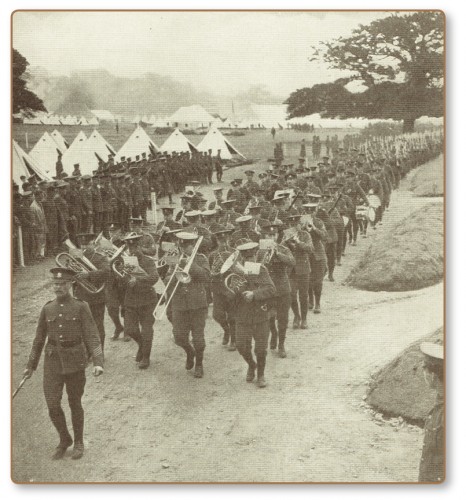
The 2nd Battalion Artists’ Rifles leaving Richmond Park for a route march, headed by their band, 1914
This idyllic scene changed abruptly when war broke out in August 1914. The army initially relied on volunteer recruits and Richmond Park was one area where units mustered and trained for action.
A hospital in the Park
As hostilities continued, more and more casualties needed medical care and attention. In 1916 a fully equipped military hospital was built in Richmond Park for South African troops injured in the fighting. With access via a new gate at Cambrian Road, it was on a large site of some 12 acres between Conduit Wood and Bishop’s Lodge, near Richmond Gate. It eventually housed over 600 beds, workshops and a concert hall. As part of the war effort, the hospital performed over 2,000 operations and treated over 9,500 patients.
During the war, morale at the hospital was maintained by a programme of activities such as concerts and fancy dress parties. Patients, staff and volunteers wrote and published a magazine, The Springbok Blue, with articles, pictures, poems and cartoons.
Nearby, the Star and Garter Home for disabled servicemen continued to support victims of the conflict after the war was over, making the most of its location just outside Richmond Gate.

‘Jackie’ the regimental mascot, a monkey who lost a leg to a German shell on the Western Front but recovered to re-join his unit at Richmond.
© London Borough of Richmond upon Thames Local Studies Collection

One patient’s view of the journey from the Front Line to a hospital bed in Richmond Park. © London Borough of Richmond upon Thames Local Studies Collection
A top secret experiment in the Park
In the First World War over 500 people were killed in Britain in bombing raids by German airships called Zeppelins. The British government announced an award of £25,000 to anyone who could create a weapon against this alarming new threat. In response an English inventor, Harry Grindell Matthews, created an “electrical light ray” system, using selenium cells.
In a secret experiment on Pen Ponds in Richmond Park in December 1915, Matthews successfully demonstrated his invention, using a remotely controlled boat to detonate mines at a distance. Matthews won the £25,000 but the invention was never used as other means of dealing with Zeppelins were eventually adopted.

Press articles revealed the secret experiment to destroy Zeppelins. This is how the story was reported in the Illustrated London News. © Mary Evans Picture Library
The Home Front
The huge effort to fight the First World War meant that at home many women took on jobs, previously seen as exclusively for men, in sectors such as industry, munitions, transport and agriculture. By the middle of the war it was increasingly difficult to maintain the army’s front line strength. To release more soldiers to fight, the Women’s Army Auxiliary Corps (WAAC) was formed in 1917, and a unit served in Richmond Park.

